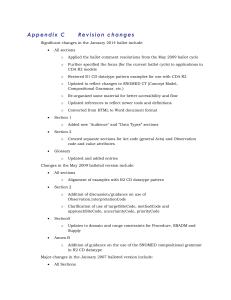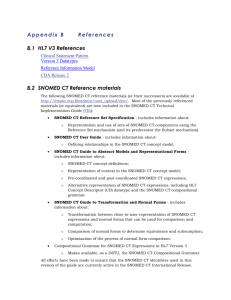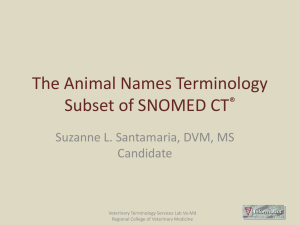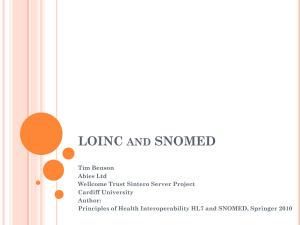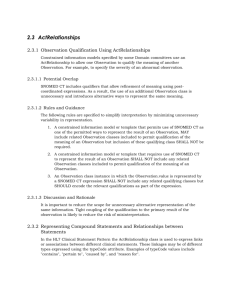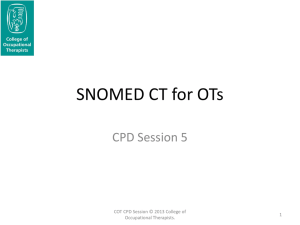B References B.1 HL7 V3 References HL7 Clinical Statement
advertisement
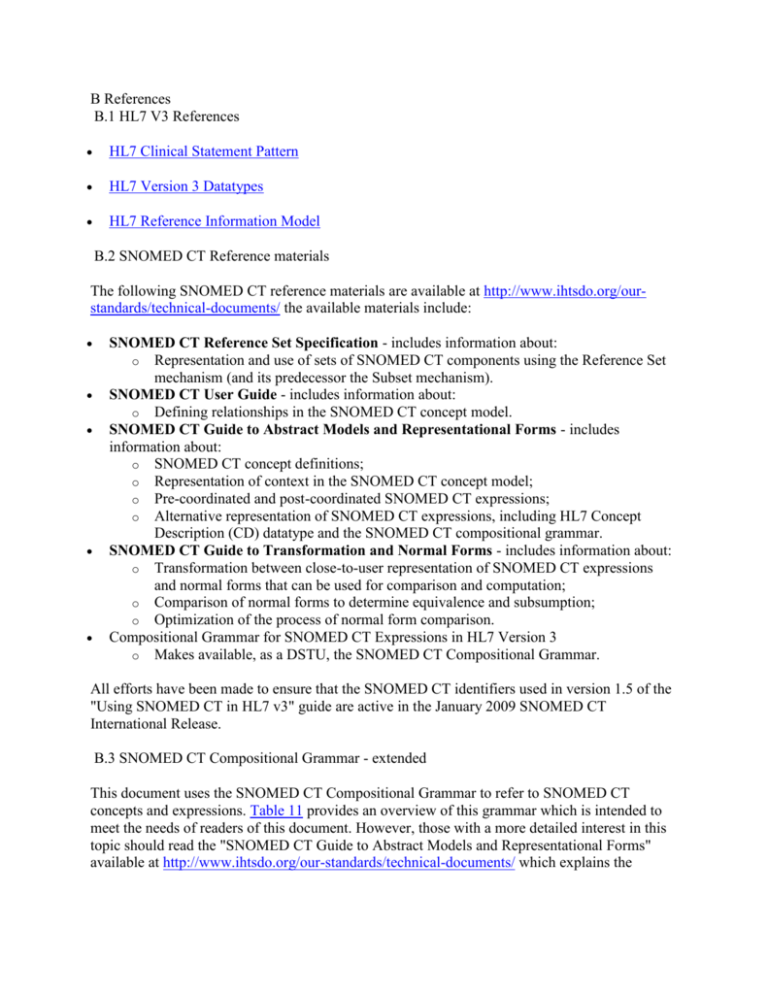
B References
B.1 HL7 V3 References
HL7 Clinical Statement Pattern
HL7 Version 3 Datatypes
HL7 Reference Information Model
B.2 SNOMED CT Reference materials
The following SNOMED CT reference materials are available at http://www.ihtsdo.org/ourstandards/technical-documents/ the available materials include:
SNOMED CT Reference Set Specification - includes information about:
o Representation and use of sets of SNOMED CT components using the Reference Set
mechanism (and its predecessor the Subset mechanism).
SNOMED CT User Guide - includes information about:
o Defining relationships in the SNOMED CT concept model.
SNOMED CT Guide to Abstract Models and Representational Forms - includes
information about:
o SNOMED CT concept definitions;
o Representation of context in the SNOMED CT concept model;
o Pre-coordinated and post-coordinated SNOMED CT expressions;
o Alternative representation of SNOMED CT expressions, including HL7 Concept
Description (CD) datatype and the SNOMED CT compositional grammar.
SNOMED CT Guide to Transformation and Normal Forms - includes information about:
o Transformation between close-to-user representation of SNOMED CT expressions
and normal forms that can be used for comparison and computation;
o Comparison of normal forms to determine equivalence and subsumption;
o Optimization of the process of normal form comparison.
Compositional Grammar for SNOMED CT Expressions in HL7 Version 3
o Makes available, as a DSTU, the SNOMED CT Compositional Grammar.
All efforts have been made to ensure that the SNOMED CT identifiers used in version 1.5 of the
"Using SNOMED CT in HL7 v3" guide are active in the January 2009 SNOMED CT
International Release.
B.3 SNOMED CT Compositional Grammar - extended
This document uses the SNOMED CT Compositional Grammar to refer to SNOMED CT
concepts and expressions. Table 11 provides an overview of this grammar which is intended to
meet the needs of readers of this document. However, those with a more detailed interest in this
topic should read the "SNOMED CT Guide to Abstract Models and Representational Forms"
available at http://www.ihtsdo.org/our-standards/technical-documents/ which explains the
underlying abstract model and includes a full Backus-Naur Form (BNF) definition of the
grammar.
The abstract model of expressions and definitions is at the heart of SNOMED CT. In contrast,
the grammar is just one way of representing instances of concepts, definitions and expressions.
As noted in the Formal rules for post-coordinated expressions (§ 1.7.5.2), there are other ways to
represent expressions, including the HL7 Concept Descriptor data type. The reason for using the
compositional grammar in this document is that it offers a terse representation which is both
human-readable and computer-processable.
The grammar used in this document extends the SNOMED CT Compositional Grammar in two
respects:
1. To improve the clarity and processability of references to SNOMED CT concepts and
expressions within blocks of narrative text:
o Compositional grammar expressions are separated from the text of the document
by square brackets (“[]”);
o The final display name delimiter is omitted (i.e. replaced by a closing square
bracket).
2. To enable a simple representation of constrained value-sets of concepts and expressions
based on post-coordinated refinement.
o To support clear documentation of relatively simple constraints, an informal
extension has been made to the compositional grammar. This extended grammar
is used in this document for pragmatic reasons. It is not proposed as a formal
extension to the SNOMED CT Compositional Grammar and has neither been
discussed or approved by the IHTSDO (http://www.ihtsdo.org) or the wider
SNOMED community.
o An informal extension has been made to the compositional grammar to represent
constraints. This extension includes:
Additional symbols specified in Table 12 to represent different types of
constraints.
Specification of the elements that can be constrained as documented in
Table 13.
Logical 'AND' and 'OR' operations as described in Table 14.
Table 11: Summary of SNOMED CT Compositional Grammar
Symbol
digits
Notes
ConceptId
Examples
A sequence of digits in an expression represents a
SNOMED CT concept identifier. The only exception to
this is where digits occur between a pair of pipe symbols,
in which case the digits are part of the display name (see
next row of this table).
The simplest expression is a concept identifier on its own.
For example:
87628006
A pair of pipe ("|") symbols are used to delimit an optional
display name for the immediately preceding concept
identifier. For example:
87628006 | bacterial infectious disease |
| text |
Display name
delimiter
The display name may be the term string of any of the
descriptions associated with the concept in a current
version of SNOMED CT. For example any the following
are a sample of valid representations of the same concept:
87628006 | bacterial infectious disease (disorder) |
87628006 | disease caused by bacteria |
87628006 | enfermedad infecciosa bacteriana |
87628006 | infección bacteriana |
Note: In this document all expressions include display
names to aid understanding. Although the Fully Specified
Name is more precise, use of the Preferred Term makes
the document easier to read and full details can be found
by looking up the concept identifier. Except where
otherwise specified, the display name used in this
document is the Preferred Term in US English in the
January 2007 SNOMED CT International Edition.
space
tab
Whitespace
linefeed characters
return
Whitespace characters are ignored and can thus be used to
format the appearance of an expression where this aids
clarity. The only exception to this rule is that spaces are
not ignored within a display name.
Note: Spaces before or after the last non whitespace
character of a display name are ignored. The text between
the pair of pipe characters is trimmed of any surrounding
whitespace but spaces within the enclosed text are treated
as part of the display name.
:
Refinement
prefix
A colon (":") precedes a refinement of meaning of the
concept to the left of the colon. A refinement consists of
one or more attributes and/or attributes groups and these
are illustrated by examples in subsequent rows of this
table.
=
Attribute value
prefix
Each of the attributes that make up a refinement consists
of an attribute name and an attribute value. The attribute
name precedes the value and is separated from it by an
equals sign ("=").
The attribute name is represented by a concept identifier
and the attribute value. The attribute value may be
represented by a concept identifier as in the following
example or by a nested expression (see example later in
this table).
The following example specifies a bacterial infectious
disease caused by streptococcus pneumoniae.
87628006 | bacterial infectious disease | :
246075003 | causative agent | = 9861002 |
streptococcus pneumoniae |
A refinement may includes more than one attribute. In this
case, a comma (",") is used to separate attributes from one
another.
,
Attribute
separator
The following example specifies a bacterial infectious
disease affecting the lung and caused by streptococcus
pneumoniae.
87628006 | bacterial infectious disease | :
246075003 | causative agent | = 9861002 |
streptococcus pneumoniae | ,
363698007 | finding site | = 39607008 | lung structure |
The value of an attribute may be represented by a nested
expression rather than a single concept identifier. In this
case, the nested expression is enclosed in parentheses.
( exp )
START
HERENested
expression
The following example specifies a bacterial infectious
disease affecting the left upper lobe of the lung and caused
by streptococcus pneumoniae. The nested expression
localizes and lateralizes the site of the disease.
87628006 | bacterial infectious disease | :
246075003 | causative agent | = 9861002 |
streptococcus pneumoniae | ,
363698007 | finding site | = (45653009 | structure of
upper lobe of lung | :
272741003 | laterality | = 7771000 | left | )
{ group
Attribute group
}
In some cases different sets of attributes apply to different
facets of the same concept. For example, some common
fractures involve two adjacent bones and the nature of the
fracture of each bone may differ. Similarly, some
procedures involve removal of one structure and repair of
another and different refinements of these actions may be
required.
In SNOMED CT concepts that have multiple facets are
defined with each facet represented by a separate
relationship group. When these concepts are refined it may
be necessary to specify which group is being refined. In
these case, curly braces are used to group together sets of
attributes that act together.
The following example represents a fracture of the shaft of
the tibia and fibula. The tibia has a spiral fracture while the
nature of the fracture of the fibula is incomplete.
271577005 | fracture of shaft of tibia and fibula | :
{116676008 | associated morphology | = 73737008 |
fracture, spiral |
,363698007 | finding site | = 52687003 | bone structure
of shaft of tibia | }
{116676008 | associated morphology | = 30543000 |
fracture, incomplete |
,363698007 | finding site | = 113224005 | bone
structure of shaft of fibula | }
87628006 | bacterial infectious disease | + 50043002 |
disorder of respiratory system |
This means a disorder that is both a bacterial disease and
disorder of the respiratory systems. For example "bacterial
pneumonia".
+
Combination
It does not mean two separate disorders that are for some
reasons are being linked. For example, this use of the plus
sign is not be the appropriate way to represent that
someone has both a separate respiratory disorder (e.g.
allergic asthma) and a separate bacterial disease (e.g.
impetigo).
Table 12: Compositional Grammar extension - Constraint symbols
Symbol
Notes
Examples
This concept
71388002 | procedure |
(No symbol prefix)
The concept "procedure" SHALL be used.
Note: By default, unless the surrounding context
states otherwise, this implies this precise concept
(i.e. not one of its subtypes). However, the context
within a sentence or parsable expression may imply
a less specific requirement. For example, if the
concept is followed by any options for addition of
refinements these implicitly permit refinement of the
concept.
<<71388002 | procedure |
Either the concept "procedure" or one of its subtypes
SHALL be used.
Note: this differs from the "<=" symbol used to
indicate the same constraint in other HL7
specifications. The reason for the difference is to
limit the use of "=" as the operator that joins an
attribute name and an attribute value in the unextended compositional grammar
<<
This concept or any
subtype permitted
<=
In HL7 Version 3 information models the symbol
"<=" is used to indicated a vocabulary domain
Deprecated symbol consisting of the specified concept or one of its
subtypes. This symbol may be confused with the use
Has same meaning as of the "=" symbol between the attribute name and
value in a post-coordinated expression. Therefore, it
<< (see above)
SHOULD be replaced by "<<" in the extended
SNOMED CT compositional grammar.
<
~
Any subtype of this
concept (but not the
concept itself)
Optional attribute
(only applicable as a
prefix to
AttributeName)
| procedure | :
363704007 | procedure site |
= ( 29836001 | hip region structure | :
272741003 | laterality | = <182353008 | side |
)
The procedure site SHALL be the value "hip region
structure" and SHALL include the attribute
"laterality" The value of "laterality" SHALL be a
subtype of "side" but SHALL NOT be "side" itself.
71388002 | procedure | :
<<363704007 | procedure site |
= ( <<29836001 | hip region structure | :
~272741003 | laterality | = <182353008 |
side | )
The attribute "procedure site" or one of its subtypes
(e.g. "procedure site – direct") SHALL be applied
and its value SHALL be "hip region structure" or
one of its subtypes. The attribute "laterality" MAY
BE applied and if present its value SHALL be a
subtype of "side" but SHALL NOT be "side" itself.
71388002 | procedure | :
363704007 | procedure site |
= ( 29836001 | hip region structure | :
!272741003 | laterality | )
!
!<
This concept is
prohibited and
SHALL NOT be
used.
This concept and all
its subtypes are
prohibited and
SHALL NOT be
used.
The procedure site SHALL be the value "hip region
structure" and SHALL NOT include the attribute
"laterality".
Note: This example conflicts with the SNOMED CT
compositional grammar as not value is supplied for
the laterality attribute. Since the laterality attribute is
not permitted, it makes no sense to provide a value.
Alternatively a dummy value could be provided but
it has been omitted here and in the examples in this
document as its would decrease rather than enhance
clarity.
71388002 | procedure | :
363704007 | procedure site |
= ( 29836001 | hip region structure | :
~272741003 | laterality | = !<66459002 |
unilateral |)
The procedure site SHALL be the value "hip region
structure" and MAY include the attribute "laterality"
The value of "laterality" SHALL NOT be
"unilateral" or a subtype of "unilateral".
Table 13: Compositional Grammar Extension - Constrainable elements
Element
Notes and examples
A constraint symbol MAY directly precede a ConceptId. In this case, it
requires, allows, or prohibits use of the referenced concept (and/or
subtypes of that concept) in that logical position in the expression.
ConceptId
Unless otherwise stated, the comparison between an instance expression
and a constraint assumes both are transformed to normal forms before
testing.
For example, the following constraint:
[ 71388002 | procedure | :
260686004 | method | << 129304002 | excision – action ].
Permits expressions such as
[ 38102005 | cholecystectomy ] or [ 80146002 | appendectomy ]
because the concepts "cholecystectomy" and "appendectomy" are
defined in SNOMED CT release data as subtypes of "procedure" and
have [ 260686004 | method | = 129304002 | excision – action ].
A constraint symbol MAY directly precede the ConceptId that specifies
the name of an attribute. In this case it requires, allows or prohibits use
of that attribute (or a subtype of that attribute). Unless the use of the
attribute is prohibited, the value of that attribute MAY be separately
constrained.
Attribute
Name
The following example asserts that the attribute "procedure site" or one
of its subtypes (e.g. "procedure site – direct") SHALL be applied and its
value SHALL be "hip region structure" or one of its subtypes.
[ 71388002 | procedure | :
<<363704007 | procedure site |
= <<29836001 | hip region structure ]
Nested
Expression
A constraint symbol may directly precede an expression enclosed in
parentheses. In this case, it requires, allows or prohibits inclusion of the
parenthesized expression (and/or subtypes of that expression) in that
logical position in the expression.
Note: It is generally clearer to specify the individual constraints on the
elements within the nested expression rather than to apply a constraint to
the nested expression as a whole. However, this form is included here to
allow for ????
A constraint symbol MAY directly precede the an attribute group. In
this case, it requires, allows or prohibits inclusion of the specified group
(and/or subtypes of that group) in that logical position in the expression.
Attribute
Group
The following example asserts that the group shown or a subtype of that
group must be present. Thus this will include any abdominal excision.
[ 71388002 | procedure | :
<<{260686004 | method |= 129304002 | excision - action | ,
,405813007 | procedure site - Direct | = 113345001 | abdominal
structure | } ]
Other
The constraints cannot be used elsewhere in the expression. In particular
a constraint cannot be applied to a refinement as whole or to a display
name. Therefore, the constraint symbols cannot immediately follow the
concept identifier, nor can they precede the pipe ("|") or colon (":")
symbols.
Note: According to the HL7 TermInfo criteria Requirements and Criteria (§ 1.8 ) where
alternative representations transform to a common model of meaning either representation may
be used. The SNOMED CT Concept Model declares that two expressions that transform to the
same normal form have the same meaning. Therefore, these constraints in this document specify
the range or possible meanings, rather than the precise way a meaning is represented. From an
operational perspective it may sometimes be desirable to constrain the forms of representation
permitted within a given community or realm. In these cases, additional constraints may be
stated in an implementation profile.
Table 14: Compositional Grammar Extension - Logical constrain combinations
Symbol
OR
AND
Notes
Examples
[ 71388002 | procedure |: 363704007 |
procedure site | = (29836001 | hip
region structure |: ~ 272741003 |
Where two or more values are
permitted the set of conditions and laterality |=(7771000 | left |) OR
the individual expressions SHALL (24028007 | right |)) ]
both be enclosed in standard
curved brackets () and the word
The procedure site SHALL be the value
"OR" SHALL be placed between
"hip region structure" and MAY include
the expression.
the attribute "laterality" The value of
"laterality" SHALL be either "left" or
"right".
Where two or more conditions are
both required to apply the
individual expression SHALL be
enclosed in standard curved
brackets and the word "AND"
shall be placed between the
expressions. ((exp1) AND (exp2))
[ 71388002 | procedure |: 363704007 |
procedure site | = ( 29836001 | hip
region structure |: ~272741003 |
laterality |=((<182353008 | side |) AND
(!<66459002 | unilateral |))) ]
The procedure site SHALL be the value
"hip region structure" and MAY include
the attribute "laterality" The value of
"laterality" SHALL be a subtype of
"side" AND SHALL NOT be either
"unilateral" or a subtype of "unilateral".
B.4 Guidance on using SNOMED CT Compositional Grammar in CD R2 Datatype
B.4.1 Introduction
The HL7 v3 “Data Types – Abstract Specification, Release 2” defines what can be carried in the
Concept Description (CD) data type as “the plain code symbol defined by the code system, or an
expression in a syntax defined by the code system which describes the concept.”
In response to the requirement for “syntax defined by the code system” The IHTSDO has
published the document Compositional Grammar for SNOMED CT Expressions in HL7 Version
3”. The serialization syntax (SNOMED Compositional Grammar, SCG) defined is the same as
the ‘unextended’ syntax described in this document .
This section describes a recommended way for communicating SNOMED CT Expressions using
the HL7 v3 Concept Description (CD) datatype.
B.4.2 Rules and guidance on usage
B.4.2.1 Minimal representation
Where communicating parties agree that only ConceptId’s are required for communication,
whether single Id’s or compositional code phrases, these SHALL be communicated using
CD.code, with expressions structured according to the SCG.
Example 23. Minimal CD representation of single code (pre-coordinated) Fracture of
humerus
<value code="66308002" codeSystem="2.16.840.1.113883.6.96"/>
Example 24. Minimal CD representation of one pattern of compositional (postcoordinated) Fracture of humerus
<value code="127278005:363698007=85050009,116676008=72704001"
codeSystem="2.16.840.1.113883.6.96"/>
It is, however, likely that good recording/communication practice between communicating
parties will require the communication of associated human readable elements. Guidance is
therefore provided for the following circumstances:
B.4.2.2 Single code SNOMED CT Expression associated with a valid SNOMED CT
Description
Where a Term of a valid Description for the communicated SNOMED CT ConceptId has been
selected to make the originating record entry, or where communicating parties wish to
communicate a valid Description for a code it may be communicated as:
CD.displayName - subject to the rules of the terminology, e.g. by use of a designated reference
set that specifies the term to be selected for each code:
Example 25. valid description “Fracture of humerus” communicated as displayName
<value code="66308002" codeSystem="2.16.840.1.113883.6.96">
<displayName value="fracture of humerus"/>
</value>
CD.code, using the SCG rules:
Example 26. Minimal CD representation of single code (pre-coordinated) Fracture of
humerus
<value code="66308002|fracture of humerus|"
codeSystem="2.16.840.1.113883.6.96"/>
Both CD.code and CD.displayName:
Example 27. Valid description “Fracture of humerus” communicated as displayName
<value code="66308002|fracture of humerus|"
codeSystem="2.16.840.1.113883.6.96">
<displayName value="fracture of humerus"/>
</value>
Where both CD.code and CD.displayName are used, the terms must be the same.
CD.originalText may, of course, also be communicated - subject to the rules of the data type
specification:
Example 28. Valid description “Fracture of humerus” communicated as originalText
and displayName
<value code="66308002" codeSystem="2.16.840.1.113883.6.96">
<displayName value="fracture of humerus"/>
<originalText mediaType="text/plain" value="fracture of the
humerus"/>
</value>
B.4.2.3 Single code or compositional SNOMED CT Expression with an associated humanreadable string
Where either a pre-crafted human-readable string or a relevant fragment from analysed narrative
text is associated with a single code or compositional SNOMED CT Expression, this string
SHALL be communicated as CD.originalText:
Example 29. Text string “Open repair of outlet of muscular interventricular septum”
communicated with associated code-only compositional code phrase
<code
code="387713003:363704007=264116001,260507000=129236007,260686004=257903006"
codeSystem="2.16.840.1.113883.6.96">
<originalText mediaType="text/plain" value="Open repair of outlet of
muscular interventricular septum"/>
</code>
Where the recording process also presents a valid SNOMED CT Description (or Descriptions) to
assist in the selection/creation of the communicated SNOMED CT Expression, or where
communicating parties wish to communicate a valid Description for a code (or each code in a
compositional expression) the associated Term (or set of Terms) MAY be communicated as
follows:
Example 30. Concept representing “Open repair of outlet of muscular interventricular
septum” communicated with SCG structured code and term phrase in CD.code
<code code="387713003|Surgical procedure|:363704007|Procedure
site|=264116001|Outlet muscular
septum|,260507000|Access|=129236007|Open approach - access|"
codeSystem="2.16.840.1.113883.6.96">
<originalText mediaType="text/plain" value="Open repair of outlet of
muscular interventricular septum"/>
</code>
If communicating parties agree that CD.code will only convey ConceptIds, then there is no
current support, according to the rules of the datatype specification and the SCG rules, for
unambiguously communicating Descriptions using available CD attributes.
In future, if alternative standard term-phrase composition rules become part of the SNOMED CT
standard (and regarded as such by relevant communicating parties) then the value of
displayName could be generated according to these rules.
B.4.2.4 Compositional SNOMED CT Expression without an associated human-readable string
If neither a pre-crafted human-readable string, nor a relevant fragment from analysed narrative
text is associated with a single code or compositional SNOMED CT Expression, then:
1. The minimal representation pattern MAY be used (if this is regarded as satisfactory for
recording/communication purposes between communicating parties) – see ‘Minimal
representation’ above.
2. If recording process also presents a valid SNOMED CT Description (or Descriptions) to
assist in the selection/creation of the communicated SNOMED CT Expression, the
associated Term (or set of Terms) must be communicated in CD.code, structured
according to the SCG rules (note, this is the convention used in examples elsewhere in
this implementation guide):
Example 31. Code phrase corresponding to one representation of “Open repair of outlet
of muscular interventricular septum” communicated with SCG structured code and
term phrase in CD.code
<code code="387713003|Surgical procedure|:363704007|Procedure
site|=264116001|Outlet muscular
septum|,260507000|Access|=129236007|Open approach - access|"
codeSystem="2.16.840.1.113883.6.96"/>
B.4.3 Supporting discussion and rationale
The approach described is based on the following principles:
CD.code should only be used to communicate expressions in a syntax defined by the code
system
Equality – “The equality of two CD values is determined solely based upon code and
codeSystem”. From the perspective of HL7 datatypes, "66308002" is not equivalent to
"66308002|Fracture of humerus|” – however according to SNOMED CT and the rules of the
SCG it is.
o Users wishing to test for true equality of concepts should therefore refer to SCG
guidance from the IHTSDO.
For the simple case of a single SNOMED CT code and corresponding description, use of
CD.code and CD.displayName is allowed.
